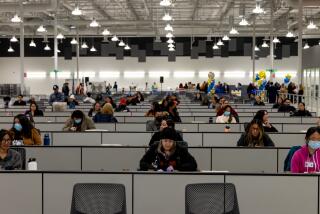California elections officials suggest schools as voting sites to ensure social distancing
Elections officials across California, seeking a way to offer in-person voting in November with strict coronavirus protections, are urging lawmakers to close schools in the days leading up to and including election day and allow campus gyms and auditoriums to be used.
The proposal comes as county officials face tight timelines to begin preparing for the Nov. 3 election and as the process has been overshadowed by Gov. Gavin Newsom’s order earlier this month to mail a ballot to every California voter.
Newsom’s effort is now mired in a legal battle with Republicans, who insist only the Legislature has the power to change election rules. Lawsuits from the Republican National Committee and former Vista Rep. Darrell Issa are challenging the May 8 executive order and President Trump has continued to insist, without proof, that voting by mail is a process rife with fraud.
The effort by local elections officials seeks to find rules for those who will vote in person, a process they argue cannot be done without a plan that allows voters several days to participate and venues that are much larger than those used in the past.
“We wanted to provide a solution” for safe voting sites, said Joe Holland, registrar of voters in Santa Barbara County and president of the California Assn. of Clerks and Elected Officials. “Schools have facilities that are big enough to accommodate in-person voting with the COVID-19 environment that we have to deal with.”
Elections officials say the four weekdays in question — Oct. 30, a Friday, through Nov. 4, a Wednesday — could easily be designated as “in-service” days, during which teachers and personnel are on campus but students are not.
Holland said public health requirements, especially regarding size and social distancing, would make most traditional polling places unworkable. Schools also would have more consistent access for disabled voters, he said, and would be found easily by voters seeking to cast their ballots.
Several prominent education groups had not heard about the proposal when contacted Friday.
State Sen. Tom Umberg (D-Santa Ana), chairman of the Senate’s elections committee, said the best path forward would be, first, to see what could be agreed to without a mandate from Sacramento.
“It does seem that schools are a community asset that is accessible,” Umberg said. “That’s a conversation to be had between local school officials and local election officials.”
Secretary of State Alex Padilla suggested Friday that the idea had merit.
“Schools and colleges alone will not provide all the voting locations we will need this November, but they have historically been a major source of voting locations, and we will need them again this fall,” he said. “The COVID-19 pandemic has presented an enormous challenge for county elections officials to adjust their operations.”
Any decision would come later than Newsom envisioned. His executive order requiring counties to mail ballots to the state’s roughly 21 million voters called for clear guidelines by the end of May on how counties would provide traditional in-person voting. At best, a decision is now unlikely before mid-June.
There were more than 2.7 million Californians who voted in person for the March presidential primary — more ballots than those cast in most states’ elections. But far more California voters, 72% of those who participated, chose to fill out a ballot sent to them in the mail.
A survey released Thursday by a team of researchers from USC, UC San Diego and UC Riverside came to a similar conclusion, finding almost 72% of eligible voters prefer either to put their ballot in the mail in November or drop them off at a location in their community. Those who don’t are more often found in communities of color or are voters with physical disabilities.
Wilma Franco, executive director of the Southeast Los Angeles Collaborative, told those attending an election webinar last week that changing those voter habits would be hard.
“It’s really going to take new ways of reaching our community,” she said during the event sponsored by the nonprofit Future of California Elections.
Exactly how many in-person voting centers will be required remains a point of contention. Fifteen California counties, choosing to embrace an optional 2016 state election law that moves away from traditional polling places, provide one location for every 10,000 voters in the final four days of an election — sites that offer a variety of voter services. But 43 other counties have chosen not to opt into that system and may find that formula difficult.
In its letter to the Legislature, the association of elections officials suggested one location for every 15,000 voters. Holland said even that standard would be challenging in some communities, especially given that the most reliable elections workers — Californians in their 60s and 70s — are also those considered to be most at risk during the pandemic.
“Can I, in good conscience, even ask them to be a poll worker in November?” Holland said.
For those who choose to vote in person in November, ideally bringing their mailed ballots with them, a number of changes are expected. Dean Logan, the registrar of voters in Los Angeles County, said Thursday during the election webinar that face coverings and gloves would be offered to Angelenos who used local voting centers in the fall.
L.A. County experienced a number of problems with in-person voting in March, but Logan told election advocates during Thursday’s event that his staff believed the voting experience could be improved upon in November.
“We have to build a capacity for that,” Logan said about in-person voting. “We need to be more direct and more emphatic in informing voters that we’re open and available.”
Using schools for a four-day voting experience could hinge on money. Elections officials are already insisting November election rules can’t be implemented without additional state dollars, and schools may be hesitant to change their schedules without some sort of compensation. Funding for K-12 schools depends, in part, on daily attendance numbers.
Holland acknowledged the challenges but said the coronavirus crisis could be remembered as creating a partnership that could be used in future elections too.
“It would be a huge achievement for democracy in California,” he said. “We would be partners, and the voters and the citizens of California would greatly benefit.”
Republicans, meanwhile, continue to take aim at mail balloting. Republican National Committee Chairwoman Ronna McDaniel announced the national party’s lawsuit on Sunday through Twitter.
“His radical plan is a recipe for disaster that would create more opportunities for fraud & destroy the confidence Californians deserve to have in their elections,” McDaniel said.
The lawsuit accuses Newsom of a “brazen power grab” that would “violate eligible citizens’ right to vote.”
Responding to the lawsuit late Sunday, Padilla said on Twitter that expanding voting by mail is not a “partisan issue.”
This lawsuit is just another part of Trump’s political smear campaign against voting by mail. We will not let this virus be exploited for voter suppression,” he wrote.
Times staff writer Laura Newberry contributed to this report.
More to Read
Start your day right
Sign up for Essential California for news, features and recommendations from the L.A. Times and beyond in your inbox six days a week.
You may occasionally receive promotional content from the Los Angeles Times.







